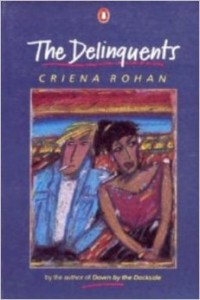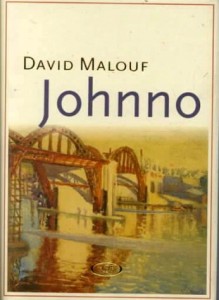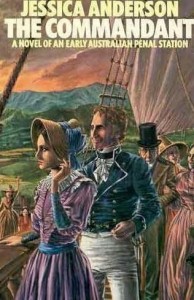 Two novels of note with Brisbane as the setting were published in the decade following Vance Palmer’s works (see earlier post “Brisbane: A Prison Within a Prison”): The Delinquents (1962) by Criena Rohan/Deirdre Cash set in the early 1960s, and The Slow Natives (1965) by Thea Astley set in the late 1950s. The Delinquents is a work of social realism that explores the experiences of two young lovers, teen rebellion and sexual promiscuity in the experimental years of the 1960s. The couple share an old Queenslander in the West End in Brisbane and the authenticity of life in an Australian city nearly a half century earlier is a feature of the book.
Two novels of note with Brisbane as the setting were published in the decade following Vance Palmer’s works (see earlier post “Brisbane: A Prison Within a Prison”): The Delinquents (1962) by Criena Rohan/Deirdre Cash set in the early 1960s, and The Slow Natives (1965) by Thea Astley set in the late 1950s. The Delinquents is a work of social realism that explores the experiences of two young lovers, teen rebellion and sexual promiscuity in the experimental years of the 1960s. The couple share an old Queenslander in the West End in Brisbane and the authenticity of life in an Australian city nearly a half century earlier is a feature of the book.
David Malouf’s Johnno (1975) describes the Brisbane of the author’s childhood in the post war years and is now perceived as the quintessential novel about Brisbane. Malouf, speaking of Johnno in the 2000 Neustadt Lecture, reinforces the notion of an under-represented Brisbane in literature and outlines his reason for writing about the city:
It was about growing up in my hometown, Brisbane, a place that for some reason had never till then got itself into a book—or not anyway in a form that had brought it alive in people’s minds and stuck. I wanted to put it on the map; to make it, in all its particularity, a place that would exist powerfully in the lives of readers in the same way that Dickens’s London does, or Dostoevsky’s Petersburg. (“A Writing Life”)
However, throughout Johnno, Malouf paints an unsightly picture of Brisbane, which Dante,  the narrator, describes as “a place where nothing happened, and where nothing ever would happen, because it had no soul. People suffered here without significance. It was too mediocre even to be a province of hell” (118). Brisbane was a place to escape from, as Dante, Johnno and their friends do, with many of them going to Europe, which Malouf implies is better than Australia.
the narrator, describes as “a place where nothing happened, and where nothing ever would happen, because it had no soul. People suffered here without significance. It was too mediocre even to be a province of hell” (118). Brisbane was a place to escape from, as Dante, Johnno and their friends do, with many of them going to Europe, which Malouf implies is better than Australia.
Johnno set the stage for the way the city was portrayed by writers in the years to follow. Since Malouf, numerous novels have been set in Brisbane, with many, such as Jessica Anderson in Tirra Lirra by the River (1978) and Thea Astley in Reaching Tin River (1990), depicting the city as backward and uninteresting, a place “to escape” from.
Malouf’s influence is still evident in one of the most recent books to feature Brisbane, Simon Cleary’s The Comfort of Figs (2008), where the author has continued in Malouf’s footsteps. Cleary’s novel is set in the present but is in part historical as it also depicts the period surrounding the construction of the bridge in the late 1930s. The Comfort of Figs is a love story and explores themes of forgiveness and self-understanding. At the start, young Canadian Freya Adams is slowly discovering the hidden layers of the city through her lover, Robbie O’Hara. The following is how she sees “her adopted town” not long after she meets Robbie:
A city of a mi llion and a half, stretching, growing. A city reaching further outwards, towards the bays and the forests and the mountain ranges she’d glimpsed from the airplane window, but couldn’t grasp when she first flew in. So much water, so many trees, so many ridge-lines. A developing city, and a place of rough politics, hard to detect. A city shaking off the past it seems half-embarrassed by. (16)
llion and a half, stretching, growing. A city reaching further outwards, towards the bays and the forests and the mountain ranges she’d glimpsed from the airplane window, but couldn’t grasp when she first flew in. So much water, so many trees, so many ridge-lines. A developing city, and a place of rough politics, hard to detect. A city shaking off the past it seems half-embarrassed by. (16)
The last sentence of this extract reflects Penton’s portrayal of Brisbane towards the end of the nineteenth century in Inheritors (1936). This inability to deal with the past, according to Cleary, is still present in the twenty-first century.
Like Johnno, Jessica Anderson’s The Commandant was published in 1975, and is the first historical novel to be set principally in Brisbane. However, it is restricted to the period surrounding Captain Logan’s death in 1830. Anderson describes the arrival in Brisbane of Frances O’Beirne, the seventeen year old fictitious sister of Logan’s wife Letty:
Again they were rounding a long point defined by the winding of the river. The gardens lay on its eastern side, and when they left them behind, and came within sight of the western bank, Frances, like Amelia herself, brought up her hands and clapped them. The row of houses set in gardens, the smoking chimneys, the tall flagstaff and spirited fluttering flag, the barge crossing the river, the windmill on the hill. The cluster of people on the wharf, all this seemed to her the essence of homeliness and familiarity. (35)
The sense of welcome expressed here by O’Beirne differs sharply to the shabbiness evoked by Penton in Landtakers set some fourteen years after The Co mmandant.
mmandant.
In The Commandant, Anderson has woven fictional characters into a historical account of life in Moreton Bay Penal Colony—as I have done in Turrwan—in 1830. By that time, Commandant Patrick Logan had gained a reputation as a harsh disciplinarian hated by the convicts under his rule. Anderson uses Frances—a somewhat naïve humanitarian—along with others such as Dr Cowper (a historical figure) to provide an insight into Logan and the workings of the settlement where they are all prisoners. Despite Frances’s early positive depiction of the colony, it was still a place to escape from, as many convicts did. In speaking of Moreton Bay Penal Colony, Mamie O’Keefe claims that,
[o]f the approximately 2062 men, 504 are known to have absconded, many of them more than once, over 700 separate abscondings in all. This is more than equivalent to one man in every three going once, and even though most of the absences were brief it clearly provided the authorities with a problem, to which various solutions were proposed.
The desire to flee Brisbane, as expressed in many novels set in the city, is perhaps, in part, an ingrained remnant, a persistent leftover from the convict era where escape was on the minds of a great number of prisoners.
